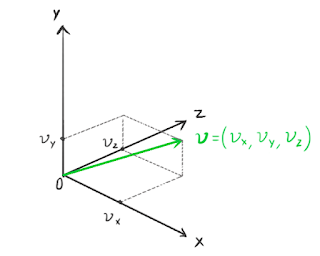3D Relativistic Velocity Addition
3D Velocity Addition
In the previous post, we saw how to work out the relative velocity of two objects moving in the same plane.We just use the equation
Relative velocity = (w - v)/ (1 - vw/c2) and this ensures nothing beats a photon in a race.
But what happens if the objects are moving wildly in 3D?
Answering this question will help us to understand momentum in special relativity which will lead us to E=mc2.
The Flying Hare And Tortoise
Imagine 2 objects moving through 3 dimensional space at velocities w and v.We will imagine a hare flying in a random direction at speed w
and a tortoise flying in a different random direction at speed v.
Firstly, we can make the job easy for ourselves by taking the direction the tortoise moves in as the x direction. This means in our stationary frame of reference, we have the tortoise moving at v in the x direction and the hare moving at w in a combination of the x, y and z directions.
We can then split the hare's velocity into the x, y and z components - wx, wyand wy.
From the stationary frame, the hare's position in space-time is given by (t, wxt , wyt , wzt )
We now want to be able to say the hare's position in space-time from the tortoise's frame of reference using the coordinates (t' , x' , y' , z' ).
We can do this easily using the Lorentz Transformations.
The location of the hare from the tortoise's POV in the x direction is giving by using the Lorentz transformation
x' = γ(x - vt)
x' = γ(wxt - vt)
x' = γt(wx - v)
The location in time of the hare from the tortoise's POV is given by
t' = γ(t - vx/c2)
t' = γ(t - vwxt/c2)
t' = γt(1 - vwx/c2)
Location in the y direction and z directions are easy because the tortoise does not move in these directions and so there are no relativistic effects. Remember, length contraction only occurs in the dimensions parallel to the moving frame of reference. The tortoise therefore sees the hare at the same y and z location as us.
y' = wyt
z' = wzt
We know the position of the hare in the x, y and z dimensions.
We know how long it takes to get to any position.
We can therefore work out the velocity from the tortoise's POV.
wx' = x' / t'
= γt(wx - v) / γt(1 - vwx/c2)
= (wxt - v) / (1 - vwx/c2)
wy' = y' / t'
= wyt / γt(1 - vwx/c2)
= wy / γ(1 - vwx/c2)
wz' = z' / t'
= wzt / γt(1 - vwx/c2)
= wz / γ(1 - vwx/c2)
The results for the y and z components of the velocity may initially surprise you. They indicate that the speed that the tortoise moves at in the x direction affects the speed of the hare in the y and z directions. We must remember that this is because of the time. When we look at the velocity of the hare in the tortoise's frame; we have to use the tortoise's dilated time. The amount the time is slowed down by depends on the velocity of the tortoise in the x direction. The velocity in all the directions will therefore be affected by this. The x direction is the special case where length contraction also comes into play.
This set of equations also ensures that nothing can go faster than light. Any values for the tortoise's speed and hare's speed will yield a result less than c. If we try and make another photon car and turn on the headlights, the equation blows up again ensuring that physics doesn't break.
Thanks for reading. If you enjoyed this post or any of my others, follow and subscribe to my blog. Feel free to discuss anything related to this post or ask questions in the comments below.
Check out my other posts on special relativity! (Link to all the posts)
How To Travel To The Future
How Galilean Relativity And The Lorenz Maxwell Equations (The 2 Postulates) Contradict
The Postulates Of Special Relativity
Did you see my previous post? Click the link below to check it out
Want to see my next post? Click the link below
Mass Increases As Speed Increases? Relativistic Mass?

Comments
Post a Comment